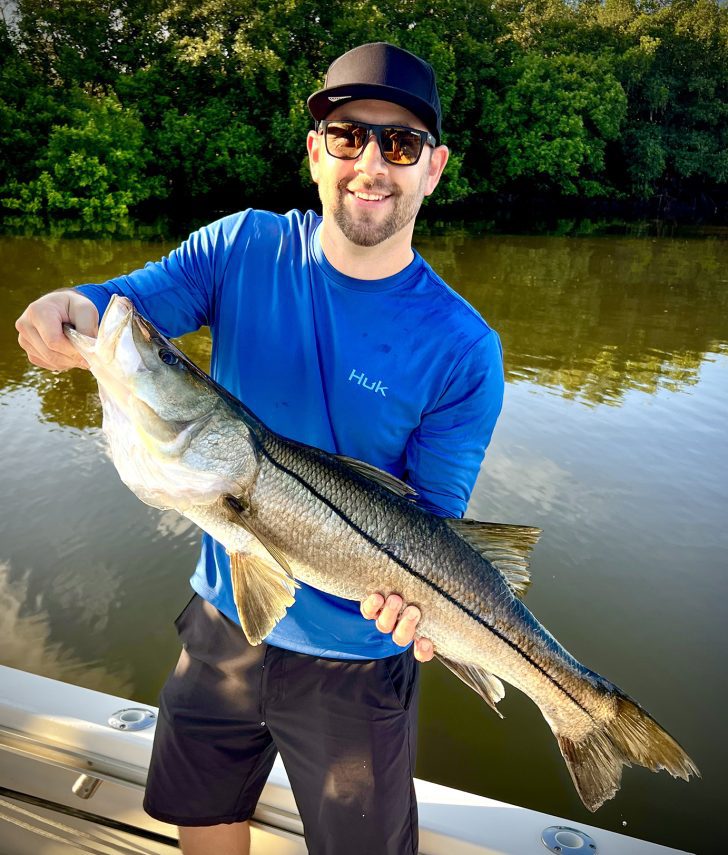November on the Flats!
Just as expected for October, the redfish bite turned on big time. This month, redfish will continue to roam most grass flats throughout Tampa Bay. Here are a few keys to success when targeting redfish.
First: If fishing a mangrove shoreline, fish tight to the mangroves. Redfish like to feed just inside the mangroves around the low hanging branches and roots. It helps to chum with live bait to draw them out of the bushes.
Second: Always be on the lookout for mullet, when pursuing redfish. Redfish usually travel within mullet schools so, when I see mullet heading my way, I take notice. If necessary, I’ll position my boat so they pass down wind within casting distance, and I’ll start live bait chumming heavily. If there are redfish mixed in with the mullet, you’ll know by the explosions on the bait that you just tossed out. The longer you chum, the more you draw to the boat.
Third: Learn to distinguish a mullet school from a redfish school–there is a subtle difference. Mullet tend to push water more aggressively than redfish and break the surface often as they move along. Of course, the tell tail sign is when they jump out of the water. However, when redfish schools move across the grass flats, especially during a high tide, their wake can be hardy noticeable. Many times, you’ll just notice a slight difference in the ripples on the water’s surface.
Remember, there’s a one fish per person, per day bag limit on redfish, and they have to measure between 18-27 inches to the tip on the tail to harvest. Any fish under or over those measurements must be released. There’s also a strict two fish per vessel limit per day, regardless of the number of passengers on board.
Now that water temperatures are on a downward trend, the snook have become more active too. With the snook spawn being over, the large females are now on the move and thinking less about love and more about food. Ten or more snook can be caught within an hour, if you hit the right spot, during good tidal flow. Just like with redfish, chum with live bait to get the action going. Some of the snook hot spots are mangrove points adjacent to deep water areas with mangroves adjacent to oyster beds and mangroves along creek or river mouths.
You only have until the end of this month to harvest snook, so make the most of it. Snook have a slot limit of not less than 28 inches or more than 33 inches. The bag limit is one fish per person, per day.
The seatrout bite has been strong all year long and continues to be robust. Grass flats in water between four to six feet deep has been the most productive for large keeper sized seatrout, but they’re active just about everywhere. Lately, it seems an outgoing tide is the most productive, as far as, sheer numbers and larger sized fish.
I like to suspend a bait under a float when fishing for seatrout to keep the bait out of the grass. Then, I’ll cast the bait 90 degrees off the side of the boat from the drift and let the tide carry the bait across the grass flat while keeping the bail open. Once a seatrout takes the float under, I close the bail with my hand, and reel until the line is tight and lift the rod for a hook set.
Seatrout have a bag limit of three fish per person and a slot limit of 15-19 inches. Here’s where it gets a little tricky: You can keep one per person over 19 inches if fishing from shore, but only one per vessel, regardless of the number of people if fishing from a boat.
As the month progresses and we move closer to December, more and more cold fronts pass through our area. Early on, the water temperature begins to drop with each passing front until it stabilizes. During this time, bait fish start leaving the grass flats for deeper water. Once the bait leaves, so do the fish.
When fish leave the shallows in search for bait, they’re more receptive to eating shrimp. The reason: Baitfish tend to move into deeper water in areas where snook, redfish and seatrout don’t generally live. Then fish tend not be as selective in what they eat.
Until then, carry on!
Afishionado, Adventures in Fishing.”

